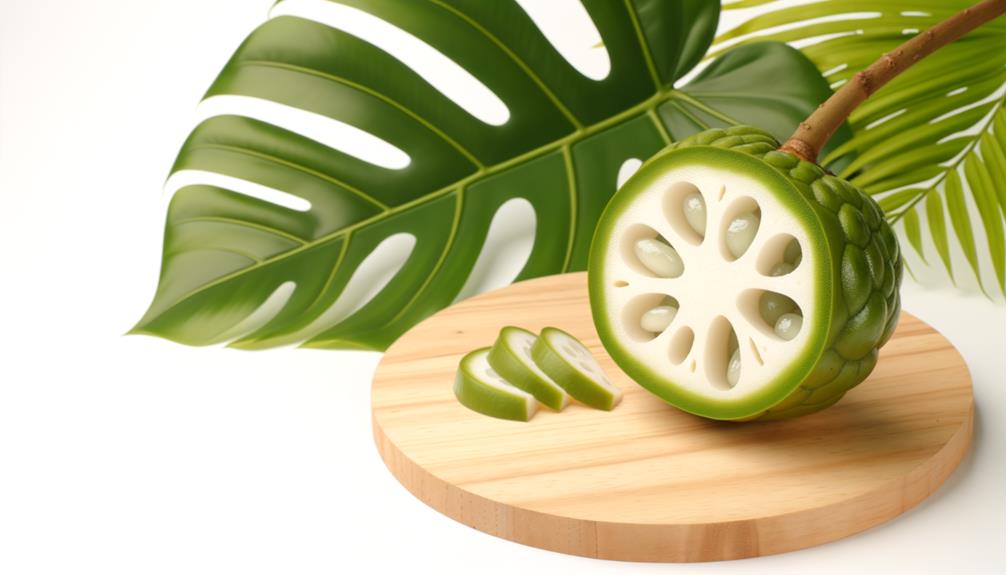Can You Eat Split Leaf Philodendron Monstera Deliciosa Fruit?
Yes, you can eat the fruit of the Split Leaf Philodendron, Monstera deliciosa, but only when it is fully ripe. Ripe fruit is indicated by a vibrant green to yellowish-green color and a sweet, aromatic scent.
Unripe fruit contains calcium oxalate crystals, which can cause severe oral and gastrointestinal irritation, including pain, swelling, nausea, and diarrhea. Proper ripeness ensures safety and peak flavor, which resembles a blend of pineapple and banana.
Harvesting at the right moment and appropriate preparation enhance the consumption experience. For an in-depth understanding of the fruit’s benefits and preparation tips, further exploration will be rewarding.

Key Takeaways
- Yes, you can eat Monstera Deliciosa fruit when it is fully ripe.
- Unripe Monstera Deliciosa fruit contains harmful calcium oxalate crystals.
- Ripe fruit has a sweet, aromatic scent and slightly soft texture.
- Ensure hexagonal scales loosen and fall off before consuming.
- Proper ripeness is crucial to avoid oral and gastrointestinal irritation.
Identifying Ripe Monstera Fruit

To accurately identify ripe Monstera deliciosa fruit, it is essential to observe the fruit’s external characteristics, such as color change and scale loosening. Initially, the fruit exhibits a vibrant green hue, evolving to a lighter yellowish-green as it matures.
A critical indicator of ripeness is the loosening or shedding of the hexagonal scales covering the fruit. This detachment begins from the base, gradually moving upward, exposing the edible flesh beneath. Additionally, a sweet, aromatic scent may emanate from the fruit, signifying its readiness for consumption.
The tactile feel of the fruit should also be noted; ripe Monstera deliciosa fruit becomes softer to the touch compared to its unripe, firmer counterpart. This combination of visual, olfactory, and tactile cues ensures accurate ripeness identification.
Risks of Unripe Fruit
Consumption of unripe Monstera deliciosa fruit poses significant health risks due to the presence of calcium oxalate crystals, which can cause irritation and inflammation of the oral mucosa and gastrointestinal tract. These needle-like crystals can induce severe pain, swelling, and potential digestive distress.
Additionally, ingestion of unripe fruit may lead to acute gastrointestinal issues such as nausea, vomiting, and diarrhea.
Calcium Oxalate Crystals
Unripe Monstera deliciosa fruit contains calcium oxalate crystals, which can pose significant health risks due to their needle-like structure and potential to cause irritation and injury to the mouth and gastrointestinal tract. These microscopic crystals, known as raphides, penetrate mucosal tissues, leading to a variety of adverse reactions.
The primary risks associated with unripe fruit consumption include:
- Oral irritation: Intense burning, swelling, and pain.
- Esophageal discomfort: Potential for swelling, leading to difficulty swallowing.
- Gastrointestinal distress: Immediate sharp pain and possible prolonged discomfort.
- Dermal reactions: Contact with skin may cause localized irritation or dermatitis.
- Potential toxicity: Ingestion of large quantities may lead to systemic toxicity.
Understanding these risks underscores the importance of ensuring the fruit is fully ripe before consumption.
Gastrointestinal Issues
Ingesting unripe Monstera deliciosa fruit can lead to significant gastrointestinal issues, primarily due to the presence of calcium oxalate crystals which cause immediate sharp pain and prolonged discomfort. These needle-shaped crystals can embed in mucous membranes, causing irritation and a burning sensation throughout the gastrointestinal tract.
This can result in symptoms such as throat swelling, difficulty swallowing, nausea, vomiting, and diarrhea. The body’s inflammatory response to these crystals exacerbates the distress, potentially leading to dehydration and further complications if not managed promptly.
Additionally, the unripe fruit contains other compounds that may exacerbate these symptoms, making it essential to verify the fruit is fully ripe before consumption. Proper identification of ripeness is crucial to avoid these adverse effects.
Harvesting Monstera Deliciosa

Harvesting Monstera deliciosa fruit necessitates a precise understanding of its ripening indicators. This includes the loosening of the hexagonal scales and the emission of a sweet fragrance. Employing suitable harvesting methods, such as cutting the fruit at its base with sanitized tools, guarantees minimal damage to the plant.
Proper post-harvest handling is crucial for maintaining the fruit’s quality and safety. This involves storing the fruit in a cool, dry environment and monitoring the sequential ripening process.
Identifying Ripe Fruit
Determining the best ripeness of Monstera deliciosa fruit involves observing specific physical characteristics. These include the loosening of its hexagonal scales and the emergence of a strong, sweet aroma. The prime time for consumption is crucial to guarantee safety and maximize flavor.
Key indicators include:
- Hexagonal Scale Loosening: Scales begin to detach, revealing the edible flesh.
- Aromatic Changes: A pronounced sweet scent indicates ripeness.
- Color Transformation: The fruit changes from green to a lighter, yellowish hue.
- Texture Softening: The flesh should yield slightly under gentle pressure.
- Absence of Irritation: Ripe fruit should not cause any tingling or irritation upon contact.
These indicators guarantee the Monstera deliciosa fruit is safe and enjoyable to eat.
Proper Harvesting Techniques
Once the fruit has reached peak ripeness, employing proper harvesting techniques guarantees both the safety of the plant and the quality of the Monstera deliciosa fruit. Begin by using disinfected pruning shears to minimize the risk of infection.
Cut the fruit at the base of its stem, ensuring a neat separation. Handle the fruit delicately to prevent bruising, which can compromise its integrity and taste. By following these meticulous practices, the plant remains healthy, promoting future yields.
| Step | Tools Required | Key Considerations |
|---|---|---|
| Inspection | Visual Acuity | Identify ripeness |
| Disinfection | Alcohol, Clean Cloth | Prevent infection |
| Cutting | Disinfected Pruning Shears | Clean cut at base |
| Handling | Gentle Hands | Avoid bruising |
These steps guarantee the Monstera deliciosa fruit maintains its best quality.
Storage and Ripening Process
Proper storage conditions and a controlled ripening process are crucial to preserving the quality and maximizing the flavor of Monstera deliciosa fruit post-harvest. The fruit, known for its unique taste, requires careful handling to guarantee peak ripeness and safety for consumption.
Key parameters for effective storage and ripening include:
- Temperature: Maintain at 12-15°C to slow down ripening.
- Humidity: Keep relative humidity levels around 85-90% to prevent dehydration.
- Ventilation: Ensure sufficient airflow to avoid mold growth.
- Ethylene Control: Utilize ethylene-absorbing materials to manage ripening.
- Observation: Monitor regularly for signs of ripeness, indicated by the peeling of hexagonal scales.
These factors collectively contribute to the fruit’s desired texture and flavor profile, making it suitable for consumption.
How to Prepare the Fruit
To prepare the Monstera deliciosa fruit, first make sure it is fully ripe, indicated by the lifting of the green scales and exposure of the edible, fragrant flesh. Gently peel away the remaining scales to reveal the yellowish-white segments beneath.
Utilizing a sharp knife, carefully slice the fruit lengthwise to facilitate easier access to the flesh. It is imperative to avoid ingesting any unripe portions, as they contain calcium oxalate crystals, which can be harmful.
Once the fruit is fully exposed, separate the edible segments from the core. Rinse the segments under cold water to remove any residual debris.
For best consumption, the cleaned flesh can now be utilized in various culinary applications, ensuring a safe and enjoyable experience.
Taste and Texture

The Monstera deliciosa fruit is characterized by a unique combination of flavors, often described as a blend of pineapple and banana, with a creamy, custard-like texture that enhances its palatability. This culinary experience is enhanced by its intricate balance of sweetness and acidity, offering a sensory delight.
Key attributes include:
- Flavor Profile: Mainly tropical, with hints of pineapple and banana.
- Texture: Silky and custard-like, contributing to a luxurious mouthfeel.
- Aroma: Fragrant and inviting, reminiscent of a tropical paradise.
- Maturity: Best when the fruit’s hexagonal scales begin to fall off.
- Consumption: Best enjoyed fresh, as the fruit can develop an unpleasant taste if overripe.
Understanding these characteristics enriches the appreciation of this exotic fruit.
Nutritional Benefits
Beyond its delightful taste and texture, Monstera deliciosa fruit provides a range of nutritional benefits that contribute to overall health and well-being.
Rich in essential vitamins and minerals, the fruit contains high levels of vitamin C, which is vital for immune function and collagen synthesis. Additionally, it offers a significant amount of dietary fiber, aiding in digestive health and promoting gastrointestinal regularity.
The fruit is also a source of potassium, essential for maintaining electrolyte balance and proper muscle function. Moreover, Monstera deliciosa contains antioxidants that help combat oxidative stress, reducing the risk of chronic diseases.
Its low-calorie content makes it a favorable option for those monitoring their energy intake while still obtaining necessary nutrients.
Conclusion
To summarize, the Monstera deliciosa fruit, when correctly identified as ripe, harvested, and prepared, offers a unique culinary experience with its distinct taste and texture.
However, the consumption of unripe fruit poses significant health risks, similar to traversing through a minefield.
The fruit’s nutritional benefits further underscore its potential value.
Consequently, precise handling and thorough knowledge are essential to safely enjoy the gastronomic and health advantages of Monstera deliciosa.






